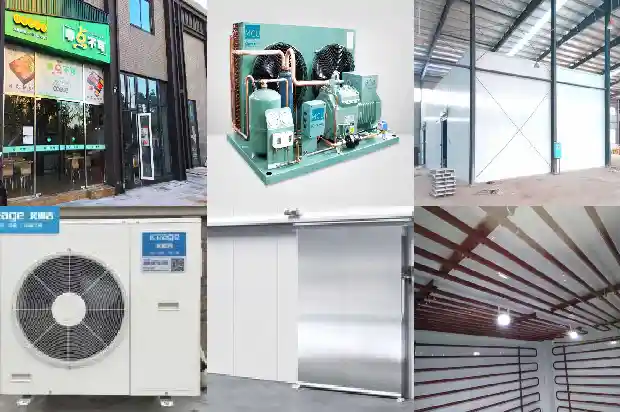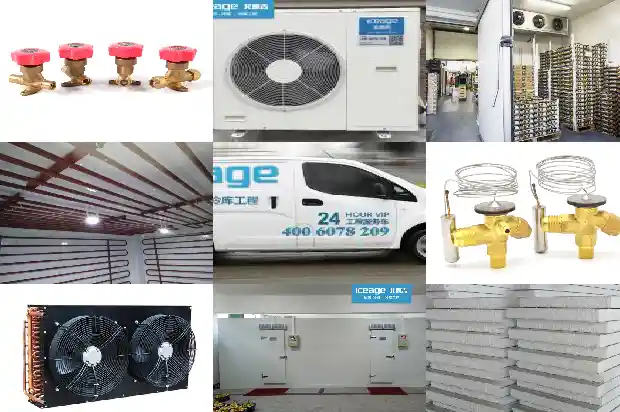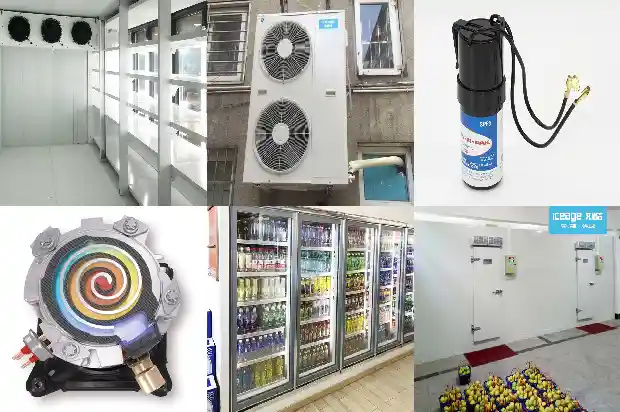Cause Analysis of High Discharge Temperature and Overload Protection of Modular Units
2025-02-28
Simply put, an air-cooled modular unit is a air-cooled chilled/hot water unit that can be freely combined. It can both cool and heat. With the characteristics of flexible installation, reliable operation, and convenient maintenance, it is suitable for building air-conditioning projects, such as hotels, apartments, hotels, office buildings, shopping malls, theaters, factories, hospitals, etc.
I. Working Cycles of Refrigeration and Heating of the Modular Unit
Refrigeration Cycle:
The low-temperature and low-pressure refrigerant gas from the indoor heat exchanger is sucked in by the compressor and compressed into high-temperature and high-pressure gas. After passing through the four-way valve, it is discharged into the outdoor heat exchanger. After exchanging heat with the outdoor air, it condenses into a refrigerant liquid. After being throttled, depressurized and cooled by the capillary tube, it enters the indoor heat exchanger. After exchanging heat with the indoor air that needs to be regulated, it becomes low-temperature and low-pressure refrigerant gas.
In this way, the cycle repeats to achieve the purpose of refrigeration.
In this way, the cycle repeats to achieve the purpose of refrigeration.
Heating Cycle:
The flow direction of the refrigerant is opposite to that during refrigeration. The high-temperature and high-pressure refrigerant gas discharged by the compressor directly enters the indoor heat exchanger after passing through the four-way valve. Under the action of the centrifugal fan, it releases heat to the indoor air and is condensed into a refrigerant liquid. After being throttled and depressurized by the main and auxiliary capillary tubes of the outdoor unit, it absorbs heat in the outdoor heat exchanger and becomes low-temperature and low-pressure refrigerant gas. It returns to the compressor through the four-way valve to complete a heat pump heating cycle. In this way, the cycle repeats to achieve the purpose of heating.
II. Overload Protection of the Compressor of the Modular Unit
The overload protection of the compressor of the modular unit is divided into the overload protection of the compressor in the refrigeration mode and the overload protection of the compressor in the heating mode, which are introduced separately below.
Overload Protection of the Compressor in the Refrigeration Mode
In the case of overload protection during refrigeration, it can be judged from the following aspects:
- Check whether the ambient temperature or water temperature is normal.
① Check the local ambient temperature. Is the ambient temperature abnormally high?
② The water temperature at the inlet and outlet of the shell-and-tube. Generally, the ambient temperature will not exceed the normal range. Mainly observe the inlet and outlet water temperatures.
If the inlet and outlet water temperatures exceed the usage requirements in the instruction manual, lower the water temperature.
- Check whether the exhaust temperature of the system is normal.
① Check the hand controller of the unit and view the "exhaust temperature". If the exhaust temperature is too high, connect a pressure gauge to the system. If the pressure value in the system corresponds to a saturation temperature that is consistent with the current ambient temperature, the refrigerant in the system is normal. If the pressure value in the system is close to the atmospheric pressure or the measured pressure value corresponds to a saturation temperature that is more than 10 degrees lower than the current ambient temperature, the refrigerant in the system is insufficient. Check the leakage points of the system (Note: The detection needs to be carried out more than 1 hour after the unit is shut down).
② Check whether the fins of the system are dirty and blocked. If the fins are very dirty, clean the fins.
③ Observe the exhaust temperature on the hand controller. If the exhaust temperature is below 55°C, immediately measure the current of the unit with a multimeter. If it is much greater than the current marked on the nameplate, it indicates that the amount of refrigerant filled in the unit is excessive. (If the compressor is overloaded and damaged due to liquid slugging, there will also be a "clicking" abnormal sound of the compressor, which mostly occurs when a newly replaced compressor is used or the unit is turned on without preheating!) - Check whether the operating voltage exceeds the usage requirements in the instruction manual.
① Measure the input voltage of the unit with a multimeter. The voltage should not exceed the usage requirements in the instruction manual (±10% of the rated voltage).
Overload Protection of the Compressor in the Heating Mode
In the case of overload protection during heating, it can be judged from the following aspects:
- Check whether the water temperature and ambient temperature exceed the usage range in the instruction manual.
Check the water temperature. The outlet water temperature should not exceed 50°C specified in the instruction manual, and the ambient temperature should not exceed 24°C specified in the instruction manual. - Check whether the water pump and the water circuit system are normal.
① Check whether there is water flow in the water pump. Observe whether there is a large vibration sound in the water system. At the same time, observe the temperature difference between the inlet and outlet water on the hand controller.
If it exceeds 8°C, it indicates insufficient water flow.
② Check whether there is air in the shell-and-tube water system. If there is a large vibration sound in the water system, it indicates incomplete air evacuation. Please continue to open the exhaust valve for air evacuation.
③ Check whether the water pump is damaged. If it is damaged, the noise of the water pump will be very loud. You can also turn on the standby water pump for flow comparison.
④ Check whether the filter of the water system is dirty and blocked. If the water flow is small, remove the filter and replace it. - Check whether the exhaust temperature of the system is normal.
① Check the hand controller of the unit and view the "exhaust temperature". If the exhaust temperature is too high, connect a pressure gauge to the system. If the pressure value in the system corresponds to a saturation temperature that is consistent with the current ambient temperature, the refrigerant in the system is normal. If the pressure value in the system is close to the atmospheric pressure or the measured pressure value corresponds to a saturation temperature that is more than 10 degrees lower than the current ambient temperature, the refrigerant in the system is insufficient. Please check the leakage points of the system (Note: The detection needs to be carried out more than 1 hour after the unit is shut down).
② Check whether the fins of the system are dirty and blocked. If the fins are very dirty, clean the fins.
③ Observe the exhaust temperature on the hand controller. If the exhaust temperature is below 55°C, immediately measure the current of the unit with a multimeter. If it is much greater than the current marked on the nameplate, it indicates that the amount of refrigerant filled in the unit is excessive. (If the compressor is overloaded and damaged due to liquid slugging, there will also be a "clicking" abnormal sound of the compressor). If it is determined that there is a problem with the compressor, please replace the compressor! - Check whether the operating voltage exceeds the usage requirements in the instruction manual. Measure the input voltage of the unit with a multimeter. The voltage should not exceed the usage requirements in the instruction manual (±10% of the rated voltage).
III. Protection for High Discharge Temperature of the Compressor of the Modular Unit
A high discharge temperature of the compressor of the modular unit is very harmful. Improper handling will threaten the life of the compressor. Common causes are:
- Refrigerant leakage. Insufficient refrigerant leads to the protection of excessive exhaust temperature during compression operation.
- Blockage of the thermal expansion valve leads to insufficient suction pressure of the compressor and protection of excessive exhaust temperature.
- Dirty blockage of the filter leads to insufficient suction pressure of the compressor and protection of excessive exhaust temperature.
- Blockage of the electronic expansion valve leads to insufficient suction pressure of the compressor and protection of excessive exhaust temperature.
Related Articles
- Analysis of the Causes and Hazards of Corrosion in the Circulating Water System
- Analysis of Common Auxiliary Components in the Refrigeration System
- Analysis of the Composition, Control and Operation Process of Cold Storage System
- Analysis of Causes for Compressor Liquid Hammer, Overheating and Pre - heating
- Analysis of Seven Reasons for Ice Formation in Computer Room Air Conditioners
- Analysis and Troubleshooting of Common Faults in Air - source Heat Pumps
- Analysis of 6 Components in Air - cooled Multi - split Systems
- Analysis of Advantages, Disadvantages and 34 Common Components of Multi - split Air Conditioners
- Common Causes and Analysis of High and Low Pressure Alarms
- Common Causes and Analysis of Compressor Thermal Protection
- Analysis of Common Faults in Compressor Overcurrent and Burnout
- Analysis of Causes for Safety Valve Leakage
- Analysis of Refrigeration Compressor Motor Faults
- Fault Analysis of Working Principle of Screw Chiller Unit
- Analysis and Treatment of Common Low-Pressure Faults in Chillers
- Analysis and Treatment of Common Low Pressure Faults in Chillers
- Water Cooled Unit Principle of Operation and Parameter Failure Analysis
- Common faults in refrigeration system (discharge temperature and pressure)
